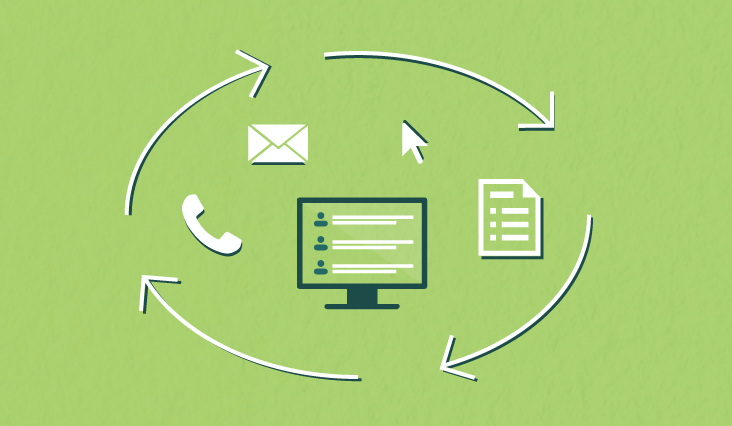Every day here at PERQ, our salespeople make tons of phone calls and send out lots of e-mails to current and prospective clients all over the country. It’s a tough job, but somebody’s gotta do it — and they do it extremely well. Like most organizations our size, we invest in a Customer Relationship Management (CRM) application to help our salespeople, well, manage their relationships with our customers.
A CRM system requires investment – of time and money – and one of our biggest challenges with CRM has been leveraging it as more than just a very expensive Rolodex. Since we added Customer Lifecycle Marketing (CLM) and a few solid processes to the mix, CRM adoption has increased dramatically among our salespeople and we’ve really begun to realize the value of both investments.
Customer Lifecycle Marketing has been a powerful driver of CRM engagement. The valuable information captured by CLM (email opens, clicks, form-fills, etc.) is pushed to CRM, where our salespeople spend their time. The combination of CLM and CRM data helps paint a clearer picture of exactly how engaged or unengaged both prospects and customers are with our brand. Instead of picking up the phone blindly, with just contact information from a database, our sales folks are fully aware of whom they’re contacting and how they interact with our emails, e-guides, social media posts, and so on. This kind of information helps our team know how to initiate a conversation with a prospect and how to maintain a lasting relationship with a customer. Here’s how your sales team can leverage Customer Lifecycle Marketing to help with CRM enablement:
Prospecting New Customers
When it comes to prospecting new customers, CRM enablement through Customer Lifecycle Marketing can prove to be exceptionally helpful. One of the biggest challenges that salespeople face is creating meaningful relationships with prospects they’ve never had any interactions with before. By bringing the activity collected by CLM into your CRM, you can at least get a high-level overview of what a prospect may or may not be interested in, and possibly a very specific idea of what they may want to buy and where they are in your funnel.
Here at PERQ, we leverage all sorts of content (blog posts, social media posts, e-mails, white papers, e-guides, etc.) in what we aptly call our “lifecycle buckets.” The first stage of PERQ’s lifecycle map is the “Universe” bucket. This bucket is essentially a holding place for every prospect we know about who might possibly be a good fit for our products and services. They’re folks who are currently in our database, but we really don’t know a whole lot about them. Much of the content created for this stage consists of informational “how-to” blog posts, introductory e-mails (basically telling prospects who we are) and social media posts. In our organization, it’s the goal of marketing to find out more about these prospects and how to best engage with them.
If a prospect in the “Universe” bucket meets specific interaction criteria with our content, they move to the “Attract” bucket, at which point sales reaches out to deepen the conversation. If the content is well received and the phone call goes well, then there’s a good chance the prospect will move to the “Convert” stage. This is the stage in which we typically introduce prospects to various types of interactive content and provide a prospect with a demo of our software.
Alternatively, a prospect might only partly engage with our content. In that event, the message from marketing might change slightly. Yes, they’ll still remain in the “Universe” stage for a bit; but the data from CLM allows sales and marketing to reevaluate their messaging in order to help nudge them further down the funnel.
Growing Relationships with Existing Customers
One significant difference between Customer Lifecycle Marketing and many marketing automation platforms is that CLM isn’t just useful for prospecting new customers. Salespeople can leverage information from CLM to grow their existing customer relationships, too.
Here at PERQ, during new customer onboarding, we send out a series of welcome e-mails along with other applicable resources (blog posts, e-guides, webinars, etc.) over the course of 2-3 weeks to ensure our new customers have everything they need to make the most of their recent purchase. The flexibility of CLM allows us to push CRM data to CLM to initiate onboarding communication, which helps reinforce sales process and ensures a consistent customer experience.
Once a customer has been onboarded, it doesn’t mean the CLM/CRM relationship is over. Quite the contrary! This is when you can begin to think about upsell opportunities, new product releases, etc., and generate specific communication from CLM based on the purchase data you store in CRM.
In our “Advocate” lifecycle bucket live our best customers. These are the folks we who give us referrals, provide testimonials, beta-test new products, etc. To move to the “Advocate” bucket in CLM, a customer first has to meet several different criteria in CRM. Because CLM and CRM are so well integrated, we can tailor delivery of content to these customers and fully leverage the relationship we’ve worked so hard to build.
CRM Enablement through Customer Lifecycle Marketing can really help your sales team to better reach out to prospective customers and create stronger, more personalized relationships with them down the road. Sure, you might not be able to convert every prospect that begins in your “Universe” stage — but the ones that do convert have a greater chance of being upsold and becoming brand advocates. The behaviors that are synced between your CLM and CRM end up becoming the basis for the entire discussion; and that’s how sales folks are able to provide their customers with the solutions they’re looking for.


Pingback: CRM and Marketing Automation Working Together | Right On Interactive